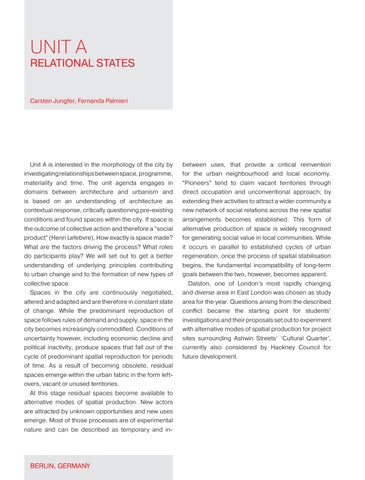UNIT A
RELATIONAL STATES Carsten Jungfer, Fernanda Palmieri
Unit A is interested in the morphology of the city by investigating relationships between space, programme, materiality and time. The unit agenda engages in domains between architecture and urbanism and is based on an understanding of architecture as contextual response, critically questioning pre-existing conditions and found spaces within the city. If space is the outcome of collective action and therefore a “social product” (Henri Lefebvre), How exactly is space made? What are the factors driving the process? What roles do participants play? We will set out to get a better understanding of underlying principles contributing to urban change and to the formation of new types of collective space. Spaces in the city are continuously negotiated, altered and adapted and are therefore in constant state of change. While the predominant reproduction of space follows rules of demand and supply, space in the city becomes increasingly commodified. Conditions of uncertainty however, including economic decline and political inactivity, produce spaces that fall out of the cycle of predominant spatial reproduction for periods of time. As a result of becoming obsolete, residual spaces emerge within the urban fabric in the form leftovers, vacant or unused territories. At this stage residual spaces become available to alternative modes of spatial production. New actors are attracted by unknown opportunities and new uses emerge. Most of those processes are of experimental nature and can be described as temporary and in-
BERLIN, GERMANY
between uses, that provide a critical reinvention for the urban neighbourhood and local economy. “Pioneers” tend to claim vacant territories through direct occupation and unconventional approach; by extending their activities to attract a wider community a new network of social relations across the new spatial arrangements becomes established. This form of alternative production of space is widely recognised for generating social value in local communities. While it occurs in parallel to established cycles of urban regeneration, once the process of spatial stabilisation begins, the fundamental incompatibility of long-term goals between the two, however, becomes apparent. Dalston, one of London’s most rapidly changing and diverse area in East London was chosen as study area for the year. Questions arising from the described conflict became the starting point for students’ investigations and their proposals set out to experiment with alternative modes of spatial production for project sites surrounding Ashwin Streets’ ‘Cultural Quarter’, currently also considered by Hackney Council for future development.
